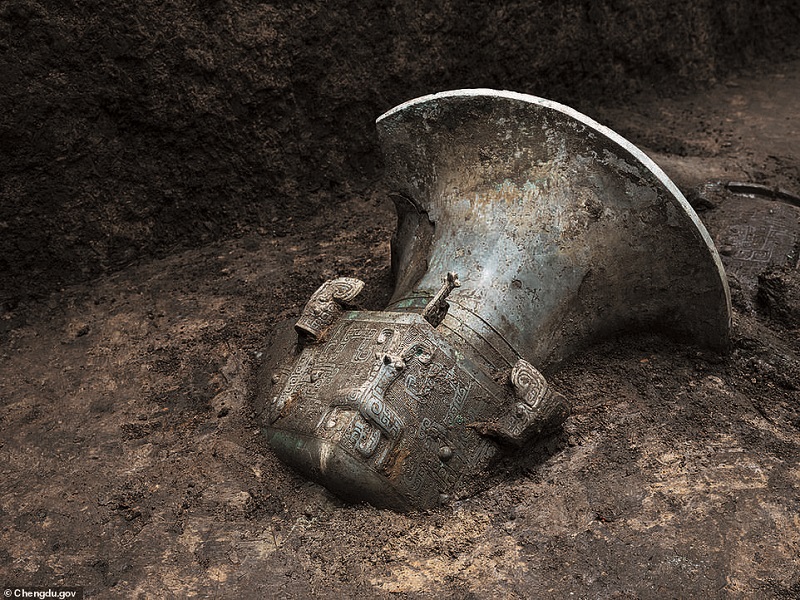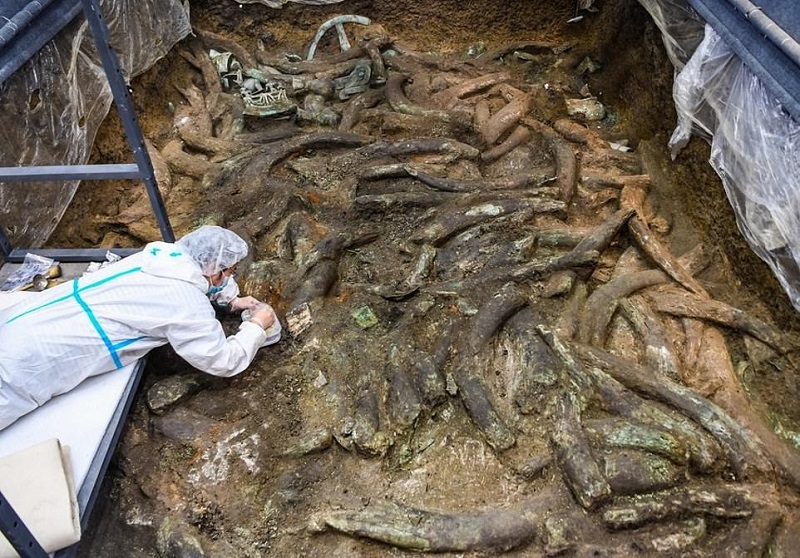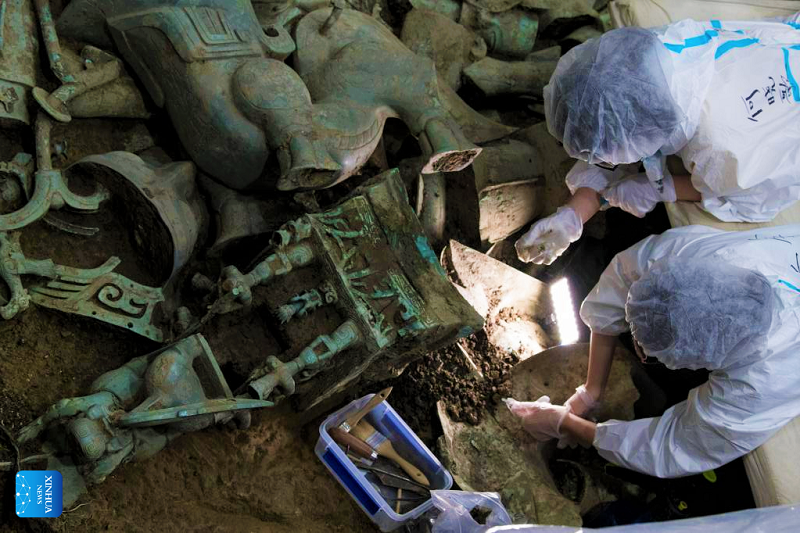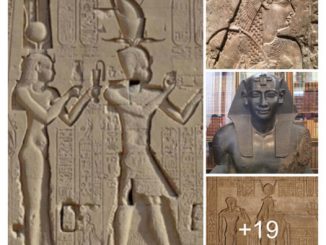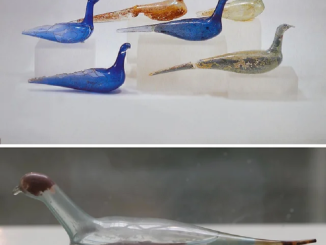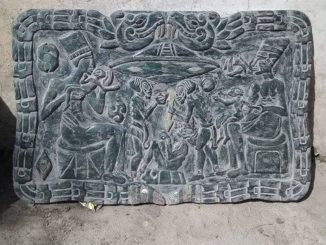Golden ceremonial mask dating back 3000 years
The priceless cultural relics – unearthed at the Sanxingdui archaeological site in the province of Sichuan, southwest China – also include bird-shaped ornaments, two kinds of silk and a bronze statue adorned with depictions of ‘beasts’.
Only about half of the gold mask is still fully intact, but experts believe it is around 84 per cent pure gold and in its original state weighed close to 500 grams (one pound).
Another gold mask, found in sacrificial pit ‘number three’, is of a similar design but is remarkably preserved and almost completely intact.
Researchers who began digging at the site in 2019 said most of the 500 items were crafted out of gold, bronze, jade and ivory, according to the South China Morning Post.
They believe the pits may have been used for sacrificial purposes by members an as-yet-unknown civilization, and that the objects now found within them were ritually burned before being buried.
A partial gold mask unearthed from the Sanxingdui Ruins site in southwest China’s Sichuan Province. Chinese archaeologists announced Saturday that some new discoveries were made at the Sanxingdui Ruins site in southwest China.
A golden mask was discovered in the third sacrificial pit of the Sanxingdui site, Sichuan province, Southwest China.
Golden ceremonial mask dating back 3000 years. Close-up of the intact and well-preserved golden mask discovered at the number three sacrificial pit of the Sanxingdui Ruins. The findings were shared in a blog post by the government of Chengdu, which is the capital of southwestern China’s Sichuan province. Sanxingdui is a well-known archaeological site and tourist hotspot outside of Chengdu. The mask and the other exciting new findings will ‘help deepen the understanding of the cultural relationship between the Chengdu Plain and the surrounding areas’, according to officials, although much mystery still surrounds the golden mask.
‘At present, it is inferred that this golden mask is also used for sacrifice, but because it is much larger than a human face, it is unlikely to be worn by a person,’ said an unnamed expert cited in the post.
The gold mask seen here in the ruins, was among more than 500 relics found in prehistoric Sanxingdui – a well-known archaeological site and tourist hotspot outside of the city of Chengdu.
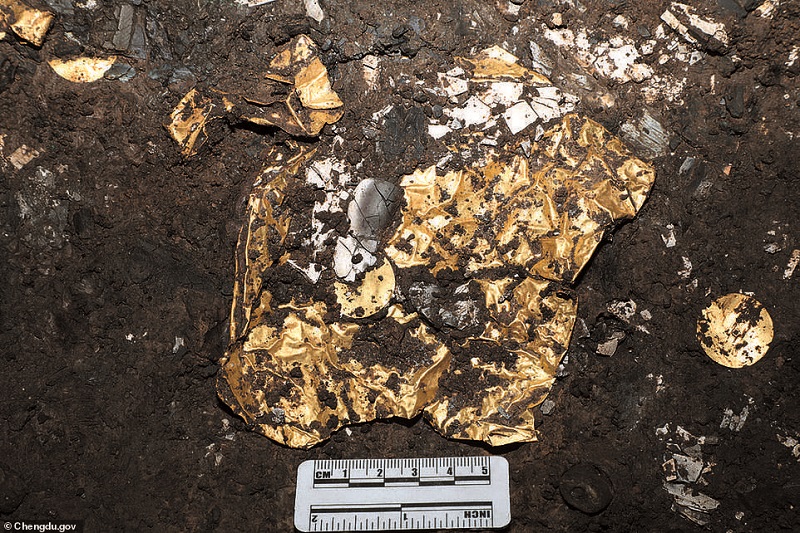
Photo taken on September 2, 2021 shows a part of a bronze altar discovered at the number eight sacrificial pit of the Sanxingdui Ruins site. ‘It is still impossible to draw an accurate conclusion at present, and further archaeological excavations are needed.’ . If the complete weight of this golden mask were more than 500 grams, it would make it the largest golden mask found in China, as well as the heaviest golden object found in the country. The mask was found in pit number five out of six, but another two pits – seven and eight – are now also being excavated and can reveal the other half. In sacral pit number three, a ‘rare, well-preserved, and exquisitely decorated’ bronze square statue, dubbed ‘Big Mouth’, was unearthed.
Sanxingdui is a well-known archaeological site and tourist hotspot outside of the city of Chengdu, in the province of Sichuan.
Pictured, ‘Big Mouth’ – a typical southern style bronze ware in the late Shang Dynasty. The Shang ruled from 1600 to 1046 B.C. and heralded the Bronze Age in China. The two-foot-tall statue – which is in a typical southern style of the late Shang Dynasty that ruled in the second millennium BC – is decorated with animal and bird heads. ‘The complete square bronze statue has never been seen before the Sanxingdui site,’ the government of Chengdu says in the post. Archaeologists said they found two kinds of silk – one in the ashes of the sacrificial pit a large amount of silk traces and the other wrapped around the bronze ware. The function of silk was raised ‘to a metaphysical level’, according to the post, when it was used for sacrificial purposes.
‘Silk serves as a carrier and medium for communication between heaven, earth, man and god,’ it says.
‘The earliest silk must not be used to make beautiful clothes, it must be used to communicate with the world, people and gods.
An archaeological works at the No. 8 sacrificial pit of the Sanxingdui Ruins site in southwest China’s Sichuan Province, September 2, 2021.
A delicate ‘bird-shaped’ gold ornament found during the recent excavations. The findings will help deepen understanding of ‘the cultural relationship between the Chengdu Plain and its surrounding areas’, experts say.
Golden ceremonial mask dating back 3000 years. ‘Bronze Sacred Tree’. The Sanxingdui site has traces of a ‘highly brilliant and splendid bronze civilization’, according to the government of Chengdu. ‘Silk, silkworm, and mulberry embodies the concept of harmony between man and nature with Chinese characteristics.’ Sanxingdui was initially stumbled upon in 1929. In 1986, two ceremonial pits containing more than 1,000 items were uncovered during a major excavation, according to CNN. One of their items unearthed from the number two sacrificial pit in 1986 was a bronze sculpture of human head with well-preserved gold mask, currently held at Sanxingdui Museum. A third pit was found in late 2019, and another five pits were found last year.
A bronze sculpture of human head with gold mask at Sanxingdui Museum in southwest China’s Sichuan Province. The sculpture was unearthed from the number two2 sacrificial pit at the Sanxingdui Ruins site in 1986.
Excavation team pictured here at the Sanxingdui site in Guanghan City, southwest China’s Sichuan Province, March 19, 2021.
Archaeologists use equipment to remotely observe the number five sacrificial pit. The pits may have been used for sacrificial purposes by members an as-yet-unknown civilization.
Archaeologists use their ‘multifunctional archaeological operating system’ on March 20 at the archaeological excavation site of Sanxingdui.





